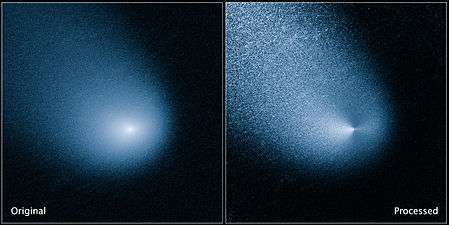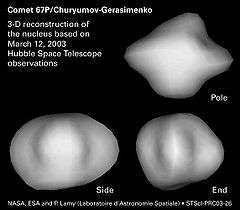(388188) 2006 DP14
| Discovery [1] | |
|---|---|
| Discovered by | LINEAR |
| Discovery site | Lincoln Lab's ETS |
| Discovery date | 23 February 2006 |
| Designations | |
| MPC designation | (388188) 2006 DP14 |
| 2006 DP14 | |
| Apollo · NEO · PHA | |
| Orbital characteristics [1] | |
| Epoch 31 July 2016 (JD 2457600.5) | |
| Uncertainty parameter 0 | |
| Observation arc | 10.10 yr (3,690 days) |
| Aphelion | 2.4263 AU |
| Perihelion | 0.3054 AU |
| 1.3658 AU | |
| Eccentricity | 0.7764 |
| 1.60 yr (583 days) | |
| 223.82° | |
| 0° 37m 3s / day | |
| Inclination | 11.788° |
| 317.28° | |
| 59.180° | |
| Earth MOID | 0.0162 AU |
| Physical characteristics | |
| Dimensions |
0.4 km[2] 0.493 km (calculated)[3] |
|
5.77±0.01 h[4] 5.78±0.02 h[5] 6 h[2] | |
| 0.20 (assumed)[3] | |
| S [3] | |
|
18.80±0.02[5] 18.9[1][3] | |
|
| |
(388188) 2006 DP14 is a highly eccentric asteroid, classified as near-Earth object and potentially hazardous asteroid of the Apollo group, approximately 400 meters in diameter. It was discovered by LINEAR at Lincoln Lab's ETS in Socorro, New Mexico, on 23 February 2006.[6] On 10 February 2014, it passed 6.2 lunar distances from Earth.[2]
The stony S-type asteroid orbits the Sun at a distance of 0.3–2.4 AU once every 1 years and 7 months (583 days). Its orbit has an eccentricity of 0.78 and an inclination of 12° with respect to the ecliptic.[1] As no precoveries were taken, the body's observation arc begins with its discovery observation in 2006.[6] The asteroid has an Earth minimum orbit intersection distance of 0.0162 AU (2,420,000 km),[1] which corresponds to the close approach distance observed in February 2014.

On the night of February 11, 2014 NASA scientists conducted a radar imaging session using the 70-meter dish at Goldstone Observatory.[2] These observations, using delay-Doppler radar imaging, revealed a 400×200 meters peanut-like shape,[2] while the Collaborative Asteroid Lightcurve Link calculates a diameter of almost 500 meters, based on an assumed standard albedo for stony asteroids of 0.20 and an absolute magnitude of 18.9.[3] Amateur and professional astronomers helped track the asteroid in the preceding days, so they would know just where to point the large antenna.[2]
Goldstone's radiometric observations also gave a rotation period of approximately 6 hours.[2] Photometric follow-up observations led to two light-curves that gave a refined period of 5.77 and 5.78 hours with a high brightness variation of 1.05 and 0.9, respectively (U=3/3).[4][5]
References
- 1 2 3 4 5 "JPL Small-Body Database Browser: 388188 (2006 DP14)" (2016-04-01 last obs.). Jet Propulsion Laboratory. Retrieved 9 September 2016.
- 1 2 3 4 5 6 7 "Radar Images of near-Earth Asteroid 2006 DP14". Jet Propulsion Laboratory. 25 February 2014. Retrieved 9 September 2016.
- 1 2 3 4 5 "LCDB Data for (388188)". Asteroid Lightcurve Database (LCDB). Retrieved 9 September 2016.
- 1 2 Warner, Brian D. (July 2014). "Near-Earth Asteroid Lightcurve Analysis at CS3-Palmer Divide Station: 2014 January-March". The Minor Planet Bulletin. 41 (3): 157–168. Bibcode:2014MPBu...41..157W. ISSN 1052-8091. Retrieved 9 September 2016.
- 1 2 3 Hicks, M.; Ebelhar, S. (February 2014). "Broad-band Photometry of the Potentially Hazardous Asteroid 2006 DP14". The Astronomer's Telegram (5928). Bibcode:2014ATel.5928....1H. Retrieved 9 September 2016.
- 1 2 "388188 (2006 DP14)". Minor Planet Center. Retrieved 9 September 2016.
External links
- Asteroid Lightcurve Database (LCDB), query form (info)
- Dictionary of Minor Planet Names, Google books
- Asteroids and comets rotation curves, CdR – Observatoire de Genève, Raoul Behrend
- Discovery Circumstances: Numbered Minor Planets (385001)-(390000) – Minor Planet Center
- (388188) 2006 DP14 at the JPL Small-Body Database


